"Went to the Exposition Tonight": Louisville's 1883 Southern Exposition
By Kathryn Anne Bratcher
Cataloging Librarian
About |
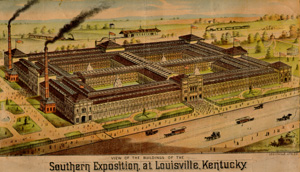 A letter to the Louisville Courier-Journal in July 1880
suggested the idea of having a grand cotton exposition in
Louisville. Louisville had held smaller expositions since
the mid-1850s, and the hope for this large-scale exhibition
was to show the South and the world that Louisville was
ready to claim her place in the trade market. The Louisville
Board of Trade quickly appointed a committee of 12 prominent
civic leaders to investigate the idea. Atlanta moved faster,
however, and announced its readiness for a cotton exposition
in late 1880.
A letter to the Louisville Courier-Journal in July 1880
suggested the idea of having a grand cotton exposition in
Louisville. Louisville had held smaller expositions since
the mid-1850s, and the hope for this large-scale exhibition
was to show the South and the world that Louisville was
ready to claim her place in the trade market. The Louisville
Board of Trade quickly appointed a committee of 12 prominent
civic leaders to investigate the idea. Atlanta moved faster,
however, and announced its readiness for a cotton exposition
in late 1880.
A second committee was appointed in October 1882. Major J. M. Wright, superintendent of the Louisville Board of Trade, was in charge of management and fundraising. Stock subscriptions were set up at $25 per share. From late November 1882 to January 1, 1883, over $221,000 was subscribed. Although short of the hoped-for $300,000, the planning and building of the Exposition proceeded. The site selected for the grounds included land from Weissinger Avenue (now Park Avenue) to Hill Street, between Fourth and Sixth streets, encompassing the existing Central Park.
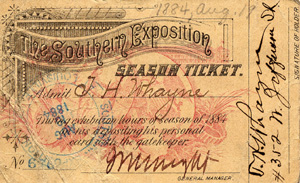 The Southern Exposition opened on August 1, 1883. Thousands
of people crowded the streets as President Chester A. Arthur
pulled a silken cord, setting the machinery in motion. Admission
was 50 cents for adults and 25 cents for children under
twelve, with a 25-cent admission for all on Saturdays. A
total of 770,048 people attended the Exposition in the first
88 days. Originally planned to be open for 100 days, the
popularity of the Southern Exposition allowed it to remain
open for several years until it ended in 1887.
The Southern Exposition opened on August 1, 1883. Thousands
of people crowded the streets as President Chester A. Arthur
pulled a silken cord, setting the machinery in motion. Admission
was 50 cents for adults and 25 cents for children under
twelve, with a 25-cent admission for all on Saturdays. A
total of 770,048 people attended the Exposition in the first
88 days. Originally planned to be open for 100 days, the
popularity of the Southern Exposition allowed it to remain
open for several years until it ended in 1887.
The Exposition’s main building was a large two-story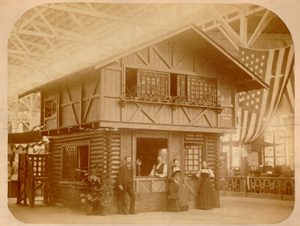 wooden and glass structure designed by McDonald Brothers
and Curtin that covered approximately 12 acres. Maps and
drawings show four interior courts with fountains that would
have provided light and ventilation within the building.
A variety of exhibits were featured around the perimeter
of the building. A branch post office, barbershop, boot-blacking
stand and restaurants were available to visitors of the
main building.
wooden and glass structure designed by McDonald Brothers
and Curtin that covered approximately 12 acres. Maps and
drawings show four interior courts with fountains that would
have provided light and ventilation within the building.
A variety of exhibits were featured around the perimeter
of the building. A branch post office, barbershop, boot-blacking
stand and restaurants were available to visitors of the
main building.
In addition to the main building, the Exposition featured a variety of curiosities for visitors to explore. A large carriage house displayed vehicles of all kinds. A lumber mill annex demonstrated modern milling techniques. A large art gallery built in Central Park held masterpieces from many famous international collections. The park also hosted several refreshment stands, a shooting gallery and a music stand. Visitors were treated to concerts, lectures, theatrical performances and weekly fireworks displays. The headquarters for the department of police and fire protection, organized to ensure the safety of visitors and exhibitors, was also located in Central Park. A police substation exists there today.
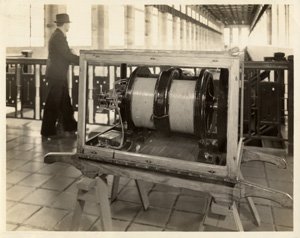 The Exposition’s agricultural department presented
a working farm and horticultural garden of about three acres,
featuring crops of cotton, tobacco, maize, hemp, flax, peanuts,
corn and castor oil plants. This department also identified
the trees in Central Park with labels.
The Exposition’s agricultural department presented
a working farm and horticultural garden of about three acres,
featuring crops of cotton, tobacco, maize, hemp, flax, peanuts,
corn and castor oil plants. This department also identified
the trees in Central Park with labels.
The use of electricity made the Southern Exposition the
first successful nighttime exposition in the country. The
exhibition grounds, main building and art gallery were illuminated
by recently introduced electric lights. Forty-six hundred
lamps, made by the Edison Company for Isolated Lighting
of New York, lit the main building. The courts and parks
were illuminated by arclights created by the Jenny Company
of Fort Wayne, Indiana. Electric lighting allowed for late
afternoon and evening entertainment with the evening highlight
being the illumination of the lights as the sun set.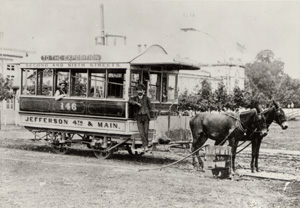
The Southern Exposition marked the beginning of a new industrial era for Louisville and other cities of the South. As stated by a Courier-Journal writer the day after the Exposition opened, "We know now that whatever is worth doing Louisville can do, and when she undertakes it, the end will be entirely satisfactory."
The Filson Historical Society is fortunate to have several
rare artifacts and items from the Southern Exposition in
its collections. The Filson’s carriage house museum
on Third Street displays some of these items.
The Filson Historical Society
1310 South Third Street - Louisville, KY
40208
Phone: (502) 635-5083 Fax: (502) 635-5086
Hours
The Ferguson Mansion and Office
Monday - Friday: 9 am. - 5 pm.
Saturday and Sunday closed
Library
Monday - Friday: 9 am. - 5 pm.
Saturday: 9 am. - 12 noon
